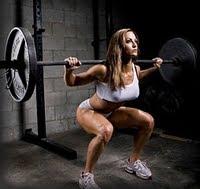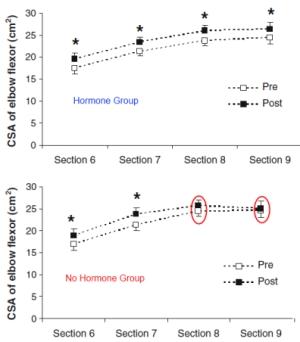Nice overview, Anoop
The Fall of the Greatest Theory of Muscle Growth - Part 2
May 22 2011
If you haven’t read the first part of the article and is not aware of the debate, please read the The Fall of the Greatest Theory of Muscle Growth. Recently, another study was conducted by a different group of authors and concluded that the acute hormone elevations may help. Now let’s take a closer look at the study titled:Physiological elevation of endogenous hormones results in superior strength training adaptation.

What was the design of the study?
- Nine untrained men performed four single joint biceps exercise per week for 11 weeks.
- For two training sessions, 3 leg exercises(leg press, leg extensions and leg curls) were performed before the bicep exercises for one of the arms (hormone Group).
- For the other two training sessions, the same protocol was performed for the other arm without the leg exercise (NO hormone group)
- This type of within-subject design ensures that motivation levels and genetics do not affect the results.
The same design was employed in the previous study too, but the big difference was that the leg exercises were performed after the arm exercises But in the current study the leg exercises were performed before the arm exercises.
What were the results of the study?
- Both group increased muscle CSA, 1RM strength, peak power and muscle volume.
- Only the hormone group obtained significant increase in muscle CSA at the part of the arm with ht e largest cross sectional area.
- Only the hormone group showed a significant improvement in 1RM strength in biceps
My Comments
- One of my concerns is the design of the study. The design of having them do leg exercises before arm exercises is not ideal. The acute increase in catecholamine and the neural drive after leg exercises makes you feel stronger which can be evident especially in smaller muscle exercises.
- The % strength increase for the no hormone group is 14% (12lbs) and 21% (18lbs) for the hormone group. In the previous study, they saw a 24% increase in strength for the no hormone group and they did only 3-4 sets compared to 6 sets in this study. That is almost twice more than what they got here!
- Though the results are statistically significant, the difference of only 5-6 lbs in 11 weeks in beginners is not really impressive.
- The muscle cross sectional area (CSA) increase was significant in all sections for both the groups except section 8 & 9 (circled in red in the figure) for the no hormone group. But the author for some reason only mentions the significant increase in section 8 of the hormone group in the abstract. In the previous study, all sections in both groups had a significant increase in CSA.
- The CSA increased more in one group, but the muscle volume inexplicably remained the same for both groups.

Practical Applications
- Even after doing 6 sets of biceps exercise after leg exercise for 11 weeks, the increase in biceps strength was only 5-6 lbs in rank beginners in the hormone group. Hence the benefits of such a training protocol for trained individuals is dubious.
- Based on this study, performing just leg exercises and increasing hormones will not make your biceps grow. You have to perform sets of bicep exercises and make sure they are done ‘right’ after the leg exercises.
- Considering that this is the only study which gives a causative role for the hormone theory, the evidence is still weak for a theory which is still the most popular theory of muscle growth.
Related Articles
Anoop | Fri May 27, 2011
Thanks Anatoly.
I know we discussed this in the forum earlier, bit I thought it is only fair to review since this study goes against the last study.
And I am sure people who still believe in the hormone hypothesis wouldn’t complain about the sample size and the design of the study of this one! In the last study, the main objections were the sample size and the design of the study. Some people also said in beginners it won’t show up and it will in trained, which makes no sense. Casey Butt even had a grandiose theory about how it will show up in trained and not in beginners. I thought it was funny.
An increase in 5 pounds for a beginner is so much weight and you’re making it seem like it really wasn’t that much. Look at like this, if the beginners were using 20 pound weights and added 5 pounds in 11 weeks they just increased their bicep curl strength by 20%.
I’m sure most lifters would be happy if they could increase their current strength by 20% on any given lift.
1. What was the Age range ? A few studies shown that untrained
people get much bigger gain then 5%.
2. Such a small study ‘benefits’ only the researcher and his PhD.
The results can NOT be applied to everyone !!!!
Sorry; the study is useless Junk.
Anoop | Thu February 09, 2012
Hi D,
Thanks for the comment
Yes, most lifters will be happy. But we don’t know if this would happen in experienced lifters.
Hi Vit,
Thanks for the comment.
1. Where did you get this 5%? I think you are thinking 5lb gain as the percentage gain.
2. How Large should a study be? It is a within subject design.
Shawn Valentine | Sat February 18, 2012
A within subject design is still only has weak-to-moderate strength associated with it and this study should be taken with a grain of salt. Anyone that is a health care practitioner and placing all the marbles into the same basket with this study is doing their patients/clients and themselves a great disservice.




